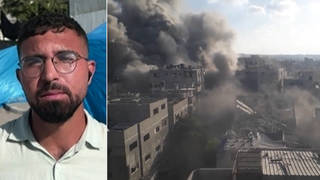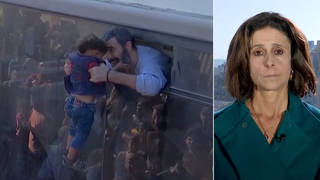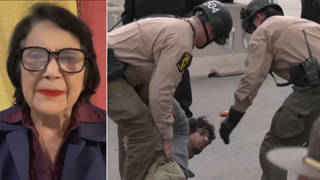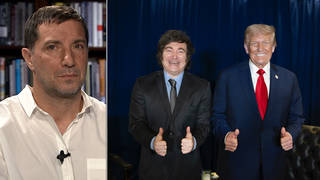
Guests
- Walden Belloexecutive director, Focus on the Global South.
- Riya OrtizFilipino Organization for Women’s Advancement, Rights, and Dignity (FORWARD) and the Inang Bayan (Motherland) Movement, which is a national alliance working for democracy in the Philippines and working to get U.S. troops out of the Philippines.
U.S. Marines came under fire from rebels in the Philippines today for the first time since beginning a training exercise in February. The Marines and Philippine soldiers returned fire, killing some of the guerrillas.
The incident is the first direct U.S. confrontation with the rebels there. It comes as President Bush is nearing a decision on a recommendation by top military officers to intensify and lengthen U.S. operations in the Philippines. At issue is the U.S. role in the combat zone on the southern Philippine island of Basilan, where more than a thousand U.S. Green Berets, Marines and Navy Seabees are stationed. The rules of engagement currently prohibit U.S. forces from joining directly in the fight against the rebels, limiting them to training efforts and firing only in self-defense.
Basilan is the site of military operations against the Abu Sayyaf, a group of Muslim guerrillas the U.S. claims has links to al-Qaeda. But some Filipino officials say the Abu Sayyaf is merely a small group of bandits, not a global terrorist organization. They say heightened U.S. involvement would probably intensify domestic opposition to Philippine President Gloria Macapagal Arroyo in a nation where the constitution forbids combat operations by foreign military personnel, except in a state of emergency.
Today we are going to talk about U.S. military intervention in the Philippines.
Transcript
AMY GOODMAN: We move now to the Philippines. U.S. Marines came under fire from rebels in the Philippines today for the first time since beginning a training exercise in February. The Marines and Philippine soldiers returned fire, killing some of the guerrillas.
The incident is the first direct U.S. confrontation with the rebels there. It comes as President Bush is nearing a decision on a recommendation by top military officers to intensify and lengthen U.S. operations in the Philippines. At issue is the U.S. role in the combat zone on the southern Philippine island of Basilan, where more than 1,000 U.S. Green Berets, Marines and Navy Seabees are stationed. The rules of engagement currently prohibit U.S. forces from joining directly in the fight against the rebels, limiting them to training efforts and, the U.S. says, firing only in self-defense.
Basilan is the site of military operations against the Abu Sayyaf, a group of Muslim guerrillas the U.S. claims have links to al-Qaeda. But some Filipino officials say the Abu Sayyaf is merely a small group of bandits, not a global terrorist organization. They say heightened U.S. involvement would probably intensify domestic opposition to the Philippine president, Gloria Arroyo, in a nation where the constitution forbids combat operations by foreign military personnel, except in a state of emergency.
Today we’re going to talk about the so-called second front of the U.S. in the Philippines. On the line with us is Walden Bello, who’s executive director of Focus on the Global South, joining us from the Philippines.
Welcome to Democracy Now!, Walden Bello.
WALDEN BELLO: Hi, Amy.
AMY GOODMAN: It’s great to have you with us. You recently went down to this militarized zone. Can you tell us what you saw?
WALDEN BELLO: Yes. Well, we went there in a mission on March 23 to 27. And what we saw was a situation which was quite complex. The long and short of it is that the situation with the Abu Sayyaf is a fairly complex local problem and that the military solution of assigning U.S. troops to try to resolve a problem that has had so many roots and might even be seen to be a centuries-long problem is simply the wrong solution, so that — I’m on the road right now, by the way, but what you said about the firing on U.S. troops by rebels and it resulting in a firefight, I think this was precisely the situation that was waiting to occur with such a massive deployment of troops. It was like an event that was waiting to happen. And we had been warning about this all along. And now you’ve had the sort of induced provocation that will, in fact, lead to a self-fulfilling prophecy of a larger military buildup.
AMY GOODMAN: Can you explain who Abu Sayyaf is?
WALDEN BELLO: Well, Abu Sayyaf is indeed a small ideological group that is said to be radical Islamist, wants to build a Muslim theocratic state in the southern Philippines, that has engaged in banditry for — in fundraising for its activities. And it does have a horrific reputation, especially among the Christian population.
But at the same time, I think there are two things that have to be realized here. The Philippine government, in fact, does not claim that it has links with al-Qaeda since 1995. They cannot — they can prove that. The second thing about the Abu Sayyaf is that it is fairly well connected to the local power structure. And one can even say that it has some domestic base within the Muslim community. In other words, it is, you know, a complex phenomenon, and it is not something that is liable to a military solution, because when there are people in high places within the provincial government, as we found when this 14-person mission went there in March, where one of our — one of the things that became very stark to many of us was that there was a lot of protection for the Abu Sayyaf and that this was the reason that 6,000 Philippine troops, that were then advised by, at that time, 160 U.S. Special Forces, could not catch these people.
So, this is a political problem that finds its roots in the Muslim-Christian conflict, and that to think that a military solution would eliminate the Abu Sayyaf is just the wrong way to go. And we are now reaping the failed rescue effort, the firefight that has just occurred and a greater military involvement on the part of the United States in the area. These are just feeding on one another to just destabilize that region even further.
AMY GOODMAN: Walden Bello, what is your understanding of what happened on June 7th, when you had the Abu Sayyaf holding Martin Burnham and his wife, Gracia Burnham, as well as the Philippine hostage, Deborah Yap? They had been held for about a year. The Philippine troops move in, unclear what role the U.S. forces played, and two of the three of them, Martin Burnham and Deborah Yap, were killed. Gracia Burnham just returned to Kansas for the funeral of her husband.
WALDEN BELLO: Well, it’s said that, you know, success has 1,000 parents, and failure is an orphan. And clearly here, the United States has been trying, in a number of the accounts that I’ve read, trying to distance itself from the event, which was — as they say in commando rescue terms, it was a failure. But I think what we’ve got to realize here is that the place where the Abu Sayyaf had taken the hostages is at some distance from Basilan Island — it was in the Peninsula Zamboanga, and Zamboanga del Norte is the province — and that the tracking of the Abu Sayyaf had been facilitated by the United States, that, in fact, U.S. high-tech electronic equipment was used to assist in tracking down the Abu Sayyaf, so that, in fact, it was a joint U.S.-Philippine operation that led to the location of the Abu Sayyaf, so that —
AMY GOODMAN: And it doesn’t look like the Abu Sayyaf were the ones that killed the two hostages.
WALDEN BELLO: Well, yes, that, too. I mean, clearly, they were killed in a crossfire, so that the Philippine government initially tried to portray the Abu Sayyaf as having killed the hostages. And as Gracia herself has said, no, that her husband was caught in the crossfire, and most likely, since the the Abu Sayyaf, it was was using the hostages as a shield, the bullets most likely could not have come from them. So it was a bungled rescue attempt in which the United States did play a very strong role in terms of electronically identifying where the Abu Sayyaf was at.
AMY GOODMAN: Walden Bello, executive director of Focus on the Global South, we have to break for stations to identify themselves. When we come back, we’ll also be joined by Riya Ortiz of the Filipino Organization for Women’s Advancement, talking about the scapegoating of Filipinos here in the United States, all related to Bush’s so-called war on terror. Stay with us.
[break]
AMY GOODMAN: “Stop the War Now,” Edwin Starr, here on Democracy Now! I’m Amy Goodman, as we continue on the issue of the U.S. deepening military involvement in the Philippines and Filipinos here in the United States. Walden Bello, executive director of Focus on the Global South, is based in the Philippines. He’s now in San Francisco. Riya Ortiz is with us, who’s with the Filipino Organization for Women’s Advancement, Rights, and Dignity, known as FORWARD, and Inang Bayan, which means Motherland Movement, a national alliance working for democracy in the Philippines and working to get the U.S. troops out of the Philippines.
I thought you got the U.S. troops out of the Philippines already. Weren’t two U.S. bases already closed?
RIYA ORTIZ: Yes, there was two, but that was back in 1991. But as we all know, that the U.S. is just waiting for a pretext to gain their lost territory in the Philippines and to again intensify their military presence in the Philippines.
AMY GOODMAN: Can you talk about, very briefly, the U.S. history in the Philippines, what these two bases were, and the movement it took to get them out?
RIYA ORTIZ: OK. The U.S. has — historically, they have maintained their presence through the military bases, that were kicked out back in 1991. So, this U.S. bases are in Clark and in Subic, but because of the Filipino people’s vigilance, they were kicked out, because they were bringing in toxic waste. There was rampant prostitution around the U.S. military bases. So, the U.S. Senate — I mean, the Filipino senators voted it out, in support of the Filipino people’s demand. But ever since 1991, they had been just trying to get back their lost territory in the Philippines. They tried to pass agreements that were subsequently denied by the Filipino Congress and Senate, because of the Filipino people’s stand against the U.S. military presence.
But back in a few years ago, they were able to again do that through the Visiting Forces Agreement. So, basically, the Visiting Forces Agreement was — it was more — it was far more worse than the U.S. military bases, because basically it allowed U.S.-Filipino — I mean, the Filipino troops, the U.S. troops to come into the Philippines in 22 ports all over the country. They don’t need a visa. They don’t need passport. They don’t need driver’s license. And if they’ve killed a Filipino while they’re on duty, they cannot be tried in the Philippines. They just have to be sent back here. And with the September 11, the U.S. gave — they were given a pretext to come back to the Philippines and declare it as the second front after the War in Afghanistan.
AMY GOODMAN: What about Filipinos here in the United States post-September 11th?
RIYA ORTIZ: OK. Even before September 11, the Filipinos, as a people and as a minority group in the U.S., have always been vulnerable to racism, to racial profiling and scapegoating, just like any other community of color subjected to such prejudice here in the U.S. — cases like Joseph Ileto a few years back in San Diego, who was killed and murdered by a person who was in a killing spree, because he was thought to be Japanese. And then, before September 11, there was the case of the Gavina brothers, who accidentally killed a cop who were harassing them and who were actually beating them up. And then they were demonized in the media, saying that they were the ones who provoked and caused the death of the cop. And now they are actually incarcerated and are waiting for their life imprisonment.
So, after September 11, this only heightened the system which has already been taking place even before September 11. So, after September 11, the focus of anti-immigrant backlash was actually geared toward South Asian and the Arab community. But when the Philippines was declared as the second front of the war against terrorism, it was not shifted, but rather the anti-immigrant backlash was expanded and was geared towards the Filipino community.
AMY GOODMAN: And so, what happened? Of the numbers, we don’t even know how many people have been detained, but more than a thousand. Do you have any sense of how many are Filipino?
RIYA ORTIZ: OK. In the U.S., the Filipino community is the second-largest Asian group in the U.S. So that would composed of 2.6 million. That would be around them 2.6 million Filipinos here in the U.S. But that’s only documented, because there are a lot of, you know, undocumented Filipinos, as well. So, some concrete cases of anti-immigrant backlash that are geared specifically on Filipinos, like in San Francisco, there were 400 airline workers who were massively fired. And they were criticized for being incompetent, because they posed as security threats rather than protecting the airports in San Francisco. And this was right after the September 11 attack. And then there are also scattered but systematic raids and deportation of undocumented immigrants in Jersey City and in Kentucky, as well.
And the Fil-Ams have also been targeted for military draft, because when the 5,000-strong U.S. military troops came to the Philippines as part of the Balikatan exercises, or shoulder-to-shoulder exercises, they flaunted this eight Filipino American troops who were part of that, who were part of that group. They were flaunted and tokenized. And they were made as a symbol of the U.S.’s — or, the Filipino support, all-out support, for the U.S. war against terrorism.
AMY GOODMAN: What about the Filipinos who work at the airports? You focused on San Francisco Airport.
RIYA ORTIZ: Mm-hmm. Actually, our counterpart group in San Francisco, the Commission on Human Rights in the Philippines are focusing on that campaign. And they have been consistently educating and organizing the airline workers to relate that issue to the larger context, which is the war against terrorism, that this is not an isolated case why they are being fired, that this is in direct — this is a direct result of the anti-immigrant backlash brought by the September 11 attacks.
AMY GOODMAN: How many people, how many Filipinos working at the San Francisco Airport have been fired?
RIYA ORTIZ: Four hundred.
AMY GOODMAN: Four hundred workers at the Filipino —
RIYA ORTIZ: Yes.
AMY GOODMAN: Four hundred Filipino workers at the airport.
RIYA ORTIZ: Yes.
AMY GOODMAN: On what grounds?
RIYA ORTIZ: On what grounds? Well, like I said, they were seen as security threats, that since — by association, they’re Filipinos, and the Filipinos are supposedly harboring these terrorists back in the Philippines, so just like what the South Asians and the Arab community, you know, were subjected to, because the main perpetrators of the September 11 attacks were Arabs.
AMY GOODMAN: Were they told that they were seen as security threats, or is it part of the whole federalization of the airport workers, that they were not U.S. citizens?
RIYA ORTIZ: I think that was what was reported.
AMY GOODMAN: But it was felt that it was because they were deemed to be security threats. Walden Bello, we only have a few minutes, but you’ve put out a major report, “Basilan: The Next Afghanistan?” report of the International Peace Mission to Basilan, the trip that you went on, talking about this as a possibility. I don’t think a lot of people, it’s registered yet, the level of the U.S. military presence in the Philippines — re-presence, I guess. Can you talk, very quickly, about your major findings and what you think needs to be done right now?
WALDEN BELLO: Well, the major findings that we saw in this situation was that the Abu Sayyaf was a complex local domestic problem, and that it had to be treated that way. That was the first thing. And it had to be treated in a way that put the emphasis on the political and the peaceful and the negotiating solutions. That was the first thing that we saw.
Second is that the Abu Sayyaf clearly enjoyed support from within the local power structure. Indeed, there was very good evidence that the governor of the province, Wahab Akbar, had some very strong links to the Abu Sayyaf.
So that the third point that we saw here was that a military solution, even how many U.S. advisers you put there, and how many Philippine troops you put to hunt them down, if they were protected in high places, it would not work.
And finally, that the U.S. presence in the area was something that not only did not address the issue, because it was a primarily military solution, but that it was likely to, in fact, generate counterproductive results, such as the firefight that you have just reported on the air, that, you know, I think this was something of a self-fulfilling prophecy.
And the last point is that if the U.S. presence, in fact, does not address the local Abu Sayyaf problem, if the Abu Sayyaf is not, in fact, connected to al-Qaeda, and yet there continues to be a buildup in southern Mindanao, as well as in the rest of the Philippines, then we feel that the U.S. objective is much, much more strategic, which is to build a permanent military presence in the southern Philippines in order for it to intervene against political Islam, particularly in the southern Philippines, in Malaysia and Indonesia.
AMY GOODMAN: On that note, I want to thank you very much for being with us, Walden Bello, Focus on the Global South, Riya Ortiz of Inang Bayan, Motherland Movement.
That does it for today’s program. Democracy Now! is produced by Kris Abrams, Miranda Kennedy, Lizzy Ratner, Michael Yeh. Anthony Sloan is our engineer and music maestro. Our website, www.democracynow.org. I’m Amy Goodman. Thanks for listening.












Media Options